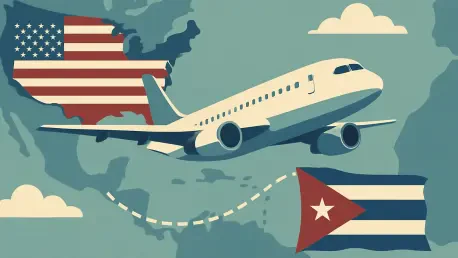As we delve into the evolving landscape of U.S.-Cuba air travel, I’m thrilled to speak with Katarina Railko, a seasoned expert in hospitality and the travel and tourism industry. With her deep understanding of international connectivity and her passion for events and expos, Katarina offers unique insights into the challenges and trends shaping air travel between these two nations. Today, we’ll explore the recent suspension of Delta Air Lines’ direct flights to Cuba, the broader implications for travelers and the industry, and what the future might hold for this critical route.
Can you walk us through the key reasons behind Delta Air Lines’ decision to suspend direct flights to Cuba starting October 26, 2025?
Certainly, Alex. Delta’s decision is primarily driven by a combination of economic struggles and escalating operational costs. Cuba is grappling with a severe economic crisis, which has directly impacted demand for air travel. Fewer people can afford to fly, both from the U.S. to Cuba and vice versa. On top of that, the costs of maintaining operations in Cuba—fuel, staffing, and regulatory compliance—have skyrocketed, making these routes unprofitable. Delta has been a key player in connecting the U.S. and Cuba, but the financial burden became unsustainable.
How has the demand for flights between the U.S. and Cuba shifted in recent years, and what’s driving those changes?
Demand has unfortunately taken a significant hit over the past few years. After the 2016 diplomatic thaw, there was a surge of interest—tourists, families, and business travelers were eager to explore or reconnect. But Cuba’s economic downturn, combined with fluctuating U.S. travel restrictions, has eroded that enthusiasm. We’ve seen fewer leisure travelers willing to navigate the regulatory maze, and even family visits have declined due to financial constraints on the Cuban side. It’s a stark contrast to the optimism we saw just a few years ago.
What specific operational hurdles has Delta encountered while running flights to Cuba?
Delta, like other carriers, has faced a range of operational challenges in Cuba. One major issue is the limited airport infrastructure, particularly in Havana, which is the primary hub. Facilities often lack the efficiency needed to handle modern airline operations, leading to delays and higher costs. Additionally, there’s a lack of connectivity beyond Havana—travelers can’t easily reach other parts of the island, which limits the appeal for tourists and makes it hard for airlines to fill seats. These logistical barriers have been a persistent headache.
When Delta resumed flights to Havana in 2016, there was a lot of hope. How did their initial expectations compare to the reality they’ve faced?
In 2016, Delta and other airlines saw the reopening of U.S.-Cuba routes as a golden opportunity. They expected a steady flow of American tourists, cultural exchanges, and business investments following the easing of tensions. The vision was to rebuild a robust travel bridge between the two nations after decades of isolation. However, reality hit hard with Cuba’s economic struggles and shifting U.S. policies tightening travel rules. Instead of growth, Delta faced declining passenger numbers and mounting losses, far from the vibrant market they had hoped for.
How does Delta’s suspension of flights affect the broader travel landscape between the U.S. and Cuba?
This suspension is a significant blow to U.S.-Cuba connectivity. For American travelers, especially those in key hubs like Atlanta and Miami, options to reach Cuba are now severely limited. The cancellation of Atlanta-Havana flights and the reduction of Miami services mean longer, more expensive journeys with connections elsewhere. For Cubans, it’s even tougher—fewer direct flights restrict their access to the U.S. and international networks, impacting everything from family reunions to economic opportunities. It’s a step backward for both sides.
We’ve seen other U.S. airlines like United and Southwest also scale back their Cuba routes. What’s fueling this industry-wide trend?
The trend across U.S. carriers stems from shared challenges. Like Delta, airlines are dealing with low demand driven by Cuba’s economic crisis and U.S. travel restrictions. Operational costs are another common pain point—maintaining flights in a market with outdated infrastructure and limited profitability is a losing battle. There’s also the uncertainty of regulatory changes from Washington, which makes long-term planning nearly impossible. It’s a perfect storm of factors pushing airlines to rethink their commitment to Cuba.
Looking at the bigger picture, how do you see Cuba’s tourism industry coping with these reduced air connections?
Cuba’s tourism industry is in for a rough patch with these cuts. Air connectivity is the lifeblood of tourism, and fewer flights mean fewer visitors, which directly hits revenue. The island was already struggling to recover from pre-pandemic levels, and this will make it harder to attract American tourists who were once a key market. Local businesses—hotels, guides, restaurants—will feel the pinch. Without significant economic or regulatory improvements, Cuba risks becoming even more isolated as a destination.
What is your forecast for the future of U.S.-Cuba air travel in the coming years?
Honestly, the outlook is uncertain, but I’m cautiously hopeful. In the short term, I expect continued challenges—more airlines may scale back until there’s stability in Cuba’s economy and clearer U.S. policies. However, if we see reforms on both sides, like eased travel restrictions or investments in Cuban infrastructure, there’s potential for a rebound. The cultural and historical ties between the U.S. and Cuba are strong, and that underlying demand could resurface. For now, though, it’s a waiting game, and travelers will need patience as this relationship evolves.









